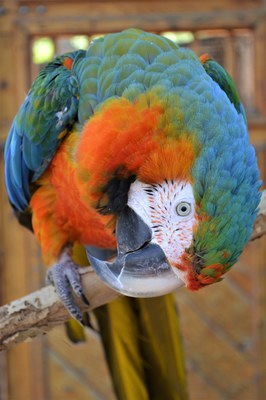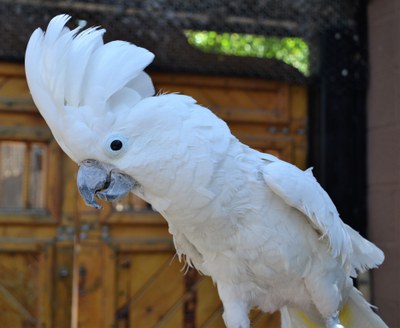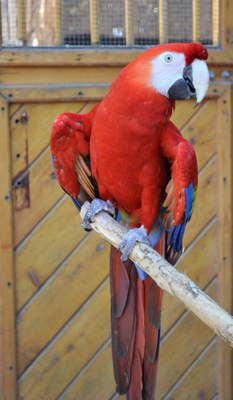Parrots
About Parrots
 There are more than 350 different parrot species in the world, and while they might have different appearances or live in different countries, they all have some adaptations in common. All parrot species have four toes on each foot, two toes pointing forward and two pointing backward. All parrots also have a large curved beak, which they use to crack open nuts and seeds.
There are more than 350 different parrot species in the world, and while they might have different appearances or live in different countries, they all have some adaptations in common. All parrot species have four toes on each foot, two toes pointing forward and two pointing backward. All parrots also have a large curved beak, which they use to crack open nuts and seeds. - Different types of parrots include conures, cockatoo, lorikeets, parakeets, macaws, Amazons, lovebirds and caiques.
- Parrots are social animals that live together in large groups, or flocks. Parrots are very noisy, so getting a lot of them in one place can really create a racket.
- Most people think that parrots can talk to them, which isn’t quite true. Parrots can imitate different sounds that they hear including what we say, so if a parrot tells you “hello,” they aren’t actually greeting you, just repeating something they heard. The parrot species best known for imitating human speech is the Amazon gray parrot. You can check one out here.
- Parrots are cavity nesting birds, which means that they build their nest in a cavity in a tree. Those trees need to be very large to accommodate some of the larger parrots. Macaws and Amazons, some of the larger parrot species, will lay one to four eggs per year.
- The kakapo is the heaviest of all the parrots, weighing up to 8.8 pounds. It is a flightless bird that is native to New Zealand and critically endangered. Birds have hollow bones to help them weigh as little as possible while they fly, so to be 8 pounds is a pretty hefty parrot!
Parrot Conservation
 Parrot populations have been in a steady decline in the wild for two big reasons: habitat loss and the pet trade. Parrot species rely heavily on trees - especially large ones - to build their nests, provide safety and get food. Many of the tropical rainforests that parrots call home are being destroyed by humans. This habitat destruction is due to a demand for resources, whether it is something being mined out of the ground, a desire for more land, or even the trees themselves. One of the biggest reasons for deforestation in Southeast Asia is palm oil, which is found in many different foods and is used as a sweetener. As a consumer, you can help prevent deforestation simply by not buying groceries that include palm oil in them or making sure to purchase products with sustainable palm oil. This simple action is something we can all do to not only help parrots, but all of the other plants and animals that live in those areas.
Parrot populations have been in a steady decline in the wild for two big reasons: habitat loss and the pet trade. Parrot species rely heavily on trees - especially large ones - to build their nests, provide safety and get food. Many of the tropical rainforests that parrots call home are being destroyed by humans. This habitat destruction is due to a demand for resources, whether it is something being mined out of the ground, a desire for more land, or even the trees themselves. One of the biggest reasons for deforestation in Southeast Asia is palm oil, which is found in many different foods and is used as a sweetener. As a consumer, you can help prevent deforestation simply by not buying groceries that include palm oil in them or making sure to purchase products with sustainable palm oil. This simple action is something we can all do to not only help parrots, but all of the other plants and animals that live in those areas.
The second reason wild parrot populations are declining is the pet trade. It’s easy to see why people are attracted to parrots; they are brightly colored and beautifully feathered. However, there are many things about parrots that make them a poor choice as a pet. Most parrots live to well over 60 years old, meaning that often parrot owners have to put them in their will because the parrot will outlive them. Another reason that parrots make poor pets is their intelligence. They are incredibly intelligent animals and whose developmental levels have been compared to a 2-3 year old human. Toddlers are delightful and fun to be around, but their temper tantrums and inability to take care of themselves makes raising a toddler a trying time for parents. The good news for toddlers is that they'll grow out of this stage and will continue to learn and develop. However, parrots will not grow intellectually, meaning pet owners are essentially caring for a toddler for more than 60 years. Despite all of this the demand for parrots continues, even for parrots that are protected by endangered species laws. Parrots are removed from the wild and sold all over the world. Anytime you purchase an animal, be it a parrot or even a puppy, it is important to know where it came from and to support reputable breeders. However, if you can adopt or care for a rescue animal, that is always the best solution. At the ABQ BioPark there are 11 education parrots. All 11 are rescue animals from people who could not provide the proper care for them or could no longer care for them. If you are a big fan of parrots, consider sponsoring one of them at the BioPark instead of buying one for yourself. This simple action will provide care and enrichment for the BioPark's animals. For more information on sponsoring check here.
Parrots at the ABQ BioPark
 Parrot Activity: Macaw, Polo!
Parrot Activity: Macaw, Polo!
Parrots fly together in large flocks and can get really noisy as they call out to each other. One of the reasons parrots are so loud is so that when they are out looking for food or stretching their wings they always know where the other parrots are. At the Indianapolis Zoo there are large flocks of macaws that soar across the sky and will call out to each other. Unlike song birds, parrots don't produce songs or trills, but rather loud noisy squawks. You can hear just how noisy here.
How to Play
Grab a couple of your friends and join a flock. Have members of the flock separate from the rest of the group into different areas where they cannot see each other. Start by having one person cry out “Macaw!” and the other members of the flock call out “polo.” The game continues as the members of the flock use their calls to identify each other’s locations and all members are reunited.
